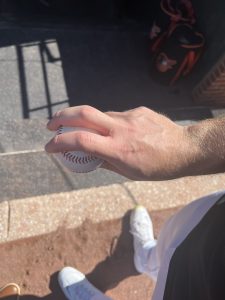Pitcher List Conversations are transcripts of interviews with professional baseball players — and sometimes, players discuss topics other than baseball. This has been lightly edited for clarity.
★ ★ ★
When the Baltimore Orioles visited Coors Field September over the Labor Day weekend, I was eager to ask Corbin Burnes a few questions. He had, after all, been traded from the Milwaukee Brewers to a very different organization. I was fortunate I got to interview him because the Orioles sent him back to Baltimore early. (One thing I’ve learned in conducting these interviews is that some teams do not keep their staters in Colorado for very long if they can help it.)
Cutter grip photo is courtesy of Orioles Baseball Communications Manager Nate Rowan. Many thanks for his help with this.
★ ★ ★
Renee Dechert: During the offseason, you were traded from to Baltimore from Milwaukee. What was that experience like?
Corbin Burnes: It was the first time in my career that I’ve been with a new organization, the first time I’ve been traded, obviously. It was definitely a new experience going into Spring Training, not really knowing anyone. I had only really known one player on the team, and I had played with him in the past, so just a complete new group of guys to get used to, new staff, just a new approach as an organization.
So the first two, three weeks were definitely a whirlwind, just trying to learn faces and names and then getting to know the team a little bit, and then how things operated. But by the end of camp, everything felt pretty normal, and I was ready to go.
RD: How have you adjusted to pitching at Camden Yards because it’s such a funky place
CB: It is, but for the way I pitch, it doesn’t really matter where I’m at — just go out there and do what I do and execute as many pitches I can and see where I’m at.
Obviously, it’s a little bit more of a pitcher-friendly ballpark than where I played in Milwaukee for years prior. So just going out and doing what I can and, hopefully, getting a win.
RD: Late in 2023, you began throwing a sweeping slider to pair with your hard slider. It was a pitch that performed and graded out well, and it seemed to suit your repertoire given how your cutter works. This year, you’ve more or less ditched it and gone back to a traditional slider, which you’ve been throwing more often than in previous years. What happened to that sweeper?
CB: It wasn’t enough of a, I would say, of a strike pitch. It was strictly a chase pitch. It worked the first two or three outings that we used it, and then by September, we just weren’t getting many swings on it. It was tough for me to throw it in the zone, just because of how much how much it broke.
For me, just the way my cutter movement was, the harder slider I felt was better suited, and once we got a hang of it this year, the results on it have been really good.
So the sweeper was just a pitch that we kind of messed with in Spring Training — couldn’t really grasp the feeling of it, as far as being in-zone enough because that was a main goal of mine this year, to attack the zone more often, get in zone more often. And that sweeper was strictly a chase pitch, which we haven’t got a ton of chase off the edge anyway, so adding that back in, I don’t think would do huge dividends right now.
Maybe it’s a pitch in a couple of years that we can bring back. It’s something I picked up in two days, so it’s something I can do pretty quickly if I need, but we just haven’t really seen a need for it yet.
RD: You’re also using your curveball more. Can you talk a bit about the evolution of that pitch?
CB: Just the way that I’ve thrown it this year has been really good compared to years past.
It’s always kind of been a pitch we rely on to steal strikes with early in counts, and then we went to more of the hard stuff for swing-and-miss this year.
This year, we’ve kind of done a little bit of everything with the curveball. Can steal strikes with it, can get swing-and-miss with it. Behind in counts, need a ground ball, we can get a ground ball with it. It’s kind of been a pitch that I can use in really any situation.
I got a really good feel for it. I can throw it in the zone, can throw it kind of wherever I want. So it’s just kind of something, the more I’ve thrown it, the more I’ve gotten confident in it — kind of like how the cutter was years ago when I started throwing it more and more, I just got more confidence I could use it a lot.
It’s a pitch that comes out of the hand for me really well, good speed difference off the cutter, being in the high 70s, low 80s, and just gives me, if I need to, just those two options to go to,
RD: Have you talked to Zach Eflin because he’s also got a pretty effective curveball?
CB: I haven’t, no. Obviously, Eflin does a lot of cool things with the baseball, too, with his sinker, and I think it’s a new split-change or whatever he’s throwing now. But his arm works a little bit different than mine. He’s more of a pronator versus me being a supinator.
But Zach does a great job of pit design and pitch shape as well.
RD: Are you still keeping your mental skills practice? That’s been a big part of your career.
CB: Absolutely, and it will be for the rest of my career.
I have a five-day routine that I stick to, both physically and mentally. The way I break down my outings, the way, really, I go about life, has come through that mental practice. I think the mental side of it got me through 2019 and kind of helped me turn the corner, so that’s definitely something I’ll continue to practice and continue to evaluate outings.
It’s freed me up. I don’t have to look at box scores and results to know how I’m doing because when I break down my outing, I’ll know. I’ll give myself a score and know what I need to work on, just all from breaking the game field down. But it’s definitely been a useful tool to get me past 2019 for sure.
RD: How has your practice evolved?
CB: Early on when I started working with Brian Cain, I did everything and anything — it was like, what I have to do to get back on track, get things going? As the years have gone along, we simplified a little bit more.
Back then, I didn’t have kids and had all day to do whatever I needed with books and that kind of stuff. So now, when the morning five or six hours is taken up by the toddler and playing with him, it becomes a little more compact when I get to the field, but it’s allowed me to have more purpose when I get to the field. I’ve got to make sure I get in there, get my stuff done, do my mental stuff, go out and get my physical work done, the pitching side of it, and all that stuff done.
We’ve simplified it, so it’s giving more of a more concrete routine and schedule on and off the field.
RD: Just three more from me. Favorite pitch you’ve thrown this season?
CB: Ooh, favorite pitch this season . . . early on, I would say just a curveball in general.
RD: Can you give me a specific incident?
CB: I mean, we can go back to Opening Day this year.
I think we had four strikeouts on the curveball — a lot of chase below — I’m trying to think.
I think it was Miguel Sanó. Maybe it was a three-pitch, I think curveball sequence, that we got to strike out on there. The curveball was really good early — the curveball has been good throughout the year.
But, then, there’s this last start against the Dodgers — the cutter.
We made a few mechanical tweaks last week to get the swing-and-miss back on the cutter. And it showed up, and we had the most swing-and-miss we’ve had in a couple of years on it. So I think it was a good trend in the right direction for the cutter.
I think I’d like the Will Smith AB, where we had two check-swing cutters on pitches that were out of the zone, which we haven’t had since, really, 2023, so it was good just to see the mechanical changes we made work, and it should be good for the rest of it.
[Here’s the first one.]
[And the second.]
RD: Can you talk a bit about the changes you made to your cutter?
CB: It wasn’t necessarily a cutter in general, just getting back to the mechanics we had in ‘22 and ‘23. We’d gotten a little bit longer, a little bit slower to the plate, and actually made the cutter more efficient, which for a cutter, is not a good thing.

Corbin Burnes Cutter Grip | Photo by Nate Rowan
So we went back to some of the mechanical stuff in ‘22 and ‘23. I went in and dug up a bunch of video and crunched the numbers and found that that was when the cutter was really the best. And, again, in one or two days of making a mechanical change, we got the results we wanted. We took it right into the game against the Dodgers and had great results with the cutter. So I think we’re definitely on the right track there.
RD: If you could steal anybody’s pitch, whose would you take and why?
CB: Oh, man. For years when I was in Milwaukee, it was always the Devin Williams changeup.
RD: What do you like about it?
CB: Guys know it’s coming, and they can’t hit it.
It was kind of the one pitch I think that I could add to my repertoire — I have a pretty good changeup, but throwing his changeup would, I think, make it even deeper. Just the utility he has: throw it for a strike, punch out, speed difference. He’s definitely got a very good feel for what he can do with his changeup.
★ ★ ★
Suggested Reading
- John Foley’s “Corbin Burnes Is Mixing It Up” (2 July 2024)

